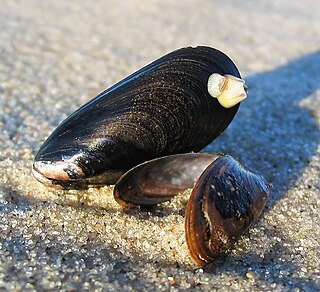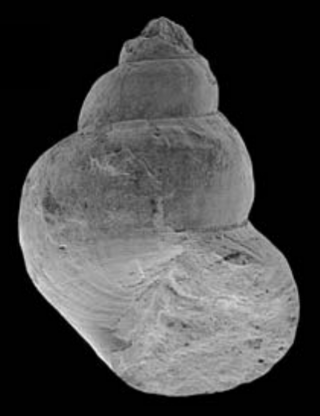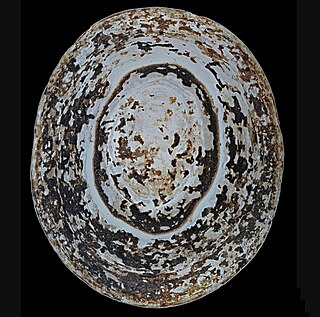
Siboglinidae is a family of polychaete annelid worms whose members made up the former phyla Pogonophora and Vestimentifera. The family is composed of around 100 species of vermiform creatures which live in thin tubes buried in sediment (Pogonophora) or in tubes attached to hard substratum (Vestimentifera) at ocean depths ranging from 100 to 10,000 m. They can also be found in association with hydrothermal vents, methane seeps, sunken plant material, and whale carcasses.

A cold seep is an area of the ocean floor where hydrogen sulfide, methane and other hydrocarbon-rich fluid seepage occurs, often in the form of a brine pool. Cold does not mean that the temperature of the seepage is lower than that of the surrounding sea water. On the contrary, its temperature is often slightly higher. The "cold" is relative to the very warm conditions of a hydrothermal vent. Cold seeps constitute a biome supporting several endemic species.

Alvinocarididae is a family of shrimp, originally described by M. L. Christoffersen in 1986 from samples collected by DSV Alvin, from which they derive their name. Shrimp of the family Alvinocarididae generally inhabit deep sea hydrothermal vent regions, and hydrocarbon cold seep environments. Carotenoid pigment has been found in their bodies. The family Alvinocarididae comprises 7 extant genera.

Mytilidae are a family of small to large marine and brackish-water bivalve molluscs in the order Mytilida. One of the genera, Limnoperna, even inhabits freshwater environments. Mytilidae, which contains some 52 genera, is the only extant family within the order Mytilida.

Provannidae is a family of deep water sea snails, marine gastropod mollusks in the superfmaily Abyssochrysoidea.

Gigantidas is a genus of large, deepwater, hydrothermal vent mussels, marine bivalve molluscs in the family Mytilidae.

Alviniconcha is a genus of deep water sea snails, marine gastropod mollusks in the family Provannidae. These snails are part of the fauna of the hydrothermal vents in the Indian and Western Pacific Ocean. These and another genus and species within the same family are the only known currently existing animals whose nutrition is derived from an endosymbiotic relationship with a member of bacteria from phylum Campylobacterota and Gammaproteobacteria, occurring as endosymbionts within the vacuoles of Alviniconcha ctenidia. All species of Alviniconcha are thought to be foundational species found near hydrothermal venting fluid supplying their bacterial endosymbionts with vent derived compounds such as hydrogen sulfide. These snails can withstand large variations in temperature, pH, and chemical compositions.

Phymorhynchus is a genus of sea snails, marine gastropod mollusks in the family Raphitomidae.

Cantrainea is a genus of sea snails, marine gastropod mollusks in the family Colloniidae.

Bruceiella is a genus of sea snails, marine gastropod mollusks in the family Skeneidae.
Thalassonerita is a monotypic genus of sea snails, marine gastropod mollusks in the family Neritidae. Its sole species is Thalassonerita naticoidea. T. naticoidea is endemic to underwater cold seeps in the northern Gulf of Mexico and in the Caribbean. Originally classified as Bathynerita, the genus was reassessed in 2019 after Thalassonerita was found to be a senior synonym of Bathynerita.

Shinkailepas is a genus of sea snails or false limpets, marine gastropod mollusks in the family Phenacolepadidae.

Provanna is a genus of sea snails, marine gastropod mollusks in the family Provannidae.

Bathymodiolus childressi is a species of deepwater mussel, a marine bivalve mollusk species in the family Mytilidae, the mussels.

Bathymodiolus thermophilus is a species of large, deep water mussel, a marine bivalve mollusc in the family Mytilidae, the true mussels. The species was discovered at abyssal depths when submersible vehicles such as DSV Alvin began exploring the deep ocean. It occurs on the sea bed, often in great numbers, close to hydrothermal vents where hot, sulphur-rich water wells up through the floor of the Pacific Ocean.
Calyptogena magnifica is a species of giant white clam found clustered around hydrothermal vents at abyssal depths in the Pacific Ocean.

Bathymodiolus marisindicus is a species of deepwater hydrothermal vent mussel, a marine bivalve mollusk species in the family Mytilidae, the mussels. This species is found in the Indian Ocean.

Bathyacmaea is a genus of deep-sea limpet, marine gastropod mollusk in the family Pectinodontidae. Species in this genus inhabit the dark, chemosynthesis-based marine communities of ocean vents and cold seeps near Japan.

Gigantidas tangaroa is a species of deep-sea mussel, a marine bivalve mollusk in the family Mytilidae, the mussels.

Bathymodiolus platifrons, described by Hashimoto and Okutani in 1994, is a deep-sea mussel that is common in hydrothermal vents and methane seeps in the Western Pacific Ocean.
















